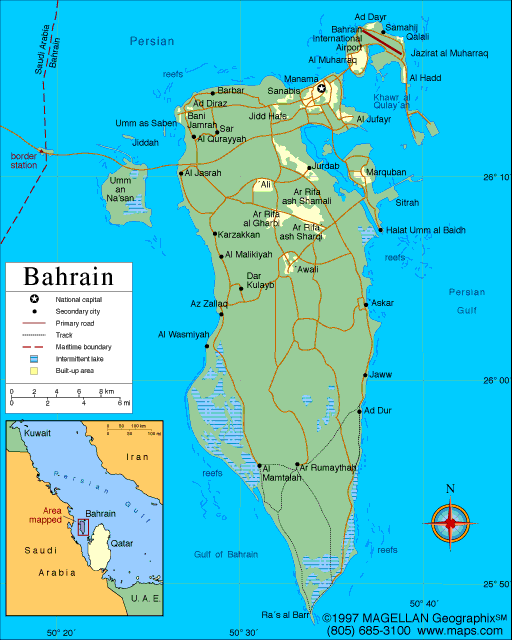BAHRAIN

Geography: Bahrain, which means “two seas,” is an archipelago in the Persian Gulf off the coast of Saudi Arabia. The islands for the most part are level expanses of sand and rock. A causeway connects Bahrain to Saudi Arabia.
Government: Constitutional monarchy.
History: Known in ancient times as Dilmun, Bahrain was an important center of trade by the 3rd millennium B.C. The islands were ruled by the Persians in the 4th century A.D. , and then by Arabs until 1541, when the Portuguese invaded them. Persia again claimed Bahrain in 1602. In 1783 Ahmad ibn al-Khalifah took over, and the al-Khalifahs remain the ruling family today. Bahrain became a British protectorate in 1820. It did not gain full independence until Aug. 14, 1971.
Although oil was discovered in Bahrain in the 1930s, it was relatively little compared to other Gulf states, and the wells are expected to be the first in the region to dry up. Sheik Isa ibn Sulman al-Khalifah, who became emir in 1961, was determined to diversify his country's economy, and he set about establishing Bahrain as a major financial center. The country provides its people with free medical care, education, and old-age pensions.
Conflicts between the Shiite and Sunni Muslims are a recurring problem in Bahrain. The Sunni minority, to which the ruling al-Khalifah family belongs, controls nearly all the power and wealth in the country. the Shiites continue to agitate for more representation in government, and minor violent clashes have led to about two dozen deaths since 1994.
History: Known in ancient times as Dilmun, Bahrain was an important center of trade by the 3rd millennium B.C. The islands were ruled by the Persians in the 4th century A.D. , and then by Arabs until 1541, when the Portuguese invaded them. Persia again claimed Bahrain in 1602. In 1783 Ahmad ibn al-Khalifah took over, and the al-Khalifahs remain the ruling family today. Bahrain became a British protectorate in 1820. It did not gain full independence until Aug. 14, 1971.
Although oil was discovered in Bahrain in the 1930s, it was relatively little compared to other Gulf states, and the wells are expected to be the first in the region to dry up. Sheik Isa ibn Sulman al-Khalifah, who became emir in 1961, was determined to diversify his country's economy, and he set about establishing Bahrain as a major financial center. The country provides its people with free medical care, education, and old-age pensions.
Conflicts between the Shiite and Sunni Muslims are a recurring problem in Bahrain. The Sunni minority, to which the ruling al-Khalifah family belongs, controls nearly all the power and wealth in the country. the Shiites continue to agitate for more representation in government, and minor violent clashes have led to about two dozen deaths since 1994.

Map of Bahrain
King: Hamad
ibn Isa al-Khalifah (1999)
Prime
Minister: Khalifah ibn Sulman al-Khalifah (1970)
Land area: 239 sq mi (619 sq km);
total area: 257 sq mi (665 sq km)
Population (2014 est.): 1,314,089 (growth
rate: 2.49%); birth rate: 13.92/1000; infant mortality rate: 9.68/1000;
life expectancy: 78.58
Capital and largest city (2011 est.):
Al-Manámah, 262,000
Monetary unit: Bahrain
dinar
National Name:
Mamlakat al Bahrayn
Languages:
Arabic (official), English, Farsi, Urdu
Ethnicity/race:
Bahraini 46%, Asian 45.5%, other Arabs 4.7%, African 1.6%,
European 1%, other 1.2% (includes Gulf Co-operative country nationals,
North and South Americans, and Oceanians) (2010 est.)
Religion:
Muslim 70.3%, Christian 14.5%, Hindu 9.8%, Buddhist 2.5%, Jewish 0.6%, folk religion
National Holiday:
National Day, December 16
Literacy rate: 94.6% (2010 est.)
Economic summary: GDP/PPP (2013 est):
$34.96 billion; per capita $29,800. Real growth rate: 4.4%.
Inflation: 3.1%. Unemployment: 15%. Arable land:
1.79%. Agriculture: fruit, vegetables; poultry, dairy
products; shrimp, fish. Labor force: 716,500; note: 44% of the
population in the 15–64 age group is non-national (2013); agriculture
1%, industry, commerce, and services 79%, government 20% (1997
est.). Industries: petroleum processing and refining, aluminum
smelting, iron pelletization, fertilizers, offshore banking, ship
repairing, tourism. Natural resources: oil, associated and
nonassociated natural gas, fish, pearls. Exports: $20.69
billion (2013 est.): petroleum and petroleum products, aluminum,
textiles. Imports: $14.41 billion (2013 est.): crude oil,
machinery, chemicals. Major trading partners: Saudi Arabia,
U.S., UAE, Japan, France, India, China (2004).
Communications: Telephones: main lines in
use: 290,000 (2012); mobile cellular: 2.125 million (2012). Broadcast media:
state-run Bahrain Radio and Television Corporation (BRTC) operates 5
terrestrial TV networks and several radio stations; satellite TV systems
provide access to international broadcasts; 1 private FM station
directs broadcasts to Indian listeners; radio and TV broadcasts from
countries in the region are available (2007). Internet hosts: 47,727 (2012).
Internet users: 419,500 (2009).
Transportation: Railways: 0 km.
Highways: total: 4,122 km; paved: 3,392
(2010). Ports and harbors: Mina' Salman, Sitrah.
Airports: 4 (2013).
International
disputes: none.
-------------------- o --------------------
No comments:
Post a Comment